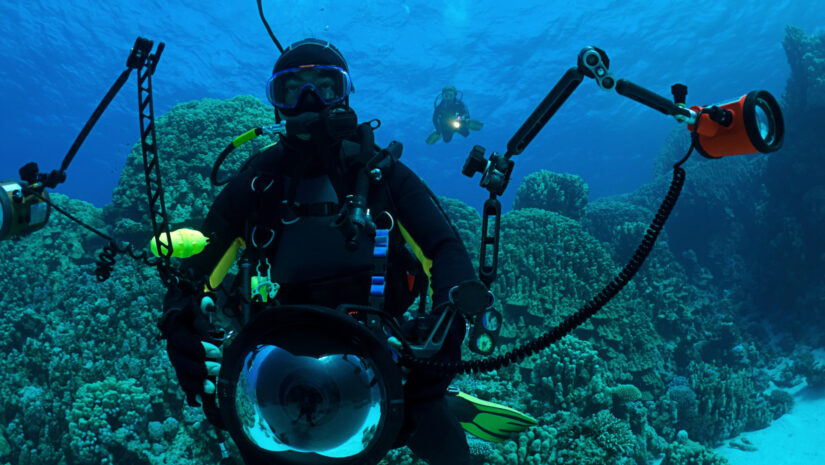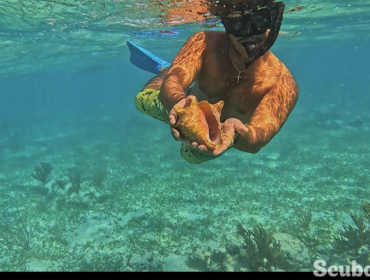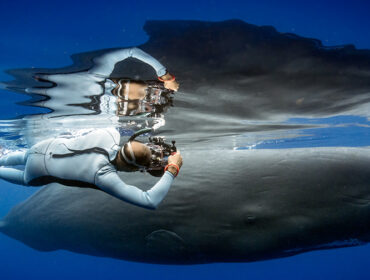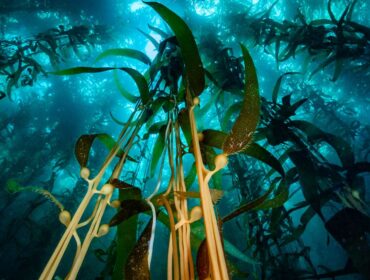Thanks to simple physics, capturing underwater images gives divers a unique challenge. Water absorbs light, and light levels quickly drop the deeper you go—which means you’ll need all the help you can get in lighting your subjects. Underwater photographers capture stills using two kinds of underwater camera lights: strobes and video lights. These essential accessories can help you get stunning images, even if you’re in the ocean’s greatest depths.
Underwater Strobe vs. Video Light: Which Light Should You Use?

If you’re into underwater photography, chances are you’ve already equipped your camera with an underwater strobe. But one question leaves many underwater photographers curious: Can you use a video light instead of an external strobe?
The answer: Yes, you can shoot stills using video lights. However, these underwater photography lights have some limitations compared to strobes. After all, strobes are specially made to capture stills.
But if you’re still not convinced, here’s a closer look at the pros and cons of using strobes and video lights for shooting stills.
Camera Focus
While underwater strobes can help diversify light scenes, giving the camera enough light to focus correctly is one challenge for these light sources. Underwater strobe lights get around this limitation by using pre-flashes. Pre-flashes fire short bursts of light before you can release your camera’s shutter so your lens can apply the right autofocus on the subject.
However, pre-flashes from strobes might not always work well when the scene has pitch-black shadows or lies in deeper water. Using video dive lights in any of the mentioned situations can help divers capture their subject. The latest video lights typically come in red mode. This feature emits a red light that cameras can easily read and use to set focus, making the light a handy focus assist beam.
Light Output
Underwater flashes come with guide numbers that serve as their actual power output. Generally, strobes with higher numbers produce stronger light. Powerful strobes are vital to full wide-angle shots and give you bright colors when you shoot. But remember: you can’t determine a strobe’s actual GN underwater. That’s due to significant changes in water visibility, which can directly affect the strobe’s reach.
Meanwhile, ordinary video dive lights won’t give you enough light for greater distances unless they’re high-powered HID (High-Intensity Discharge) lights. Essential lights usually have a range of 500 to 1,000 lumens. So, it’s better to use these light sources when shooting macro images and subjects closer to you.
But if you’re looking for a much more powerful video light, you’ve got two other options:
- Medium-range video lights with a 2,000 to 3,000 lumen range
- Stronger video lights with up to 30,000 lumens of light
Performance
When it comes to capturing fast-moving subjects, underwater strobes take the cake. These light sources not only provide light, but they also help freeze motion—something a video light can’t do. Strobes freeze quick movement by releasing light at 1/10,000 of a second. And to top it off, underwater strobes will let you use fast shutter speeds to capture your subject.
But even if underwater video lights can’t freeze fast motion, they do have one advantage over strobes. Video lights can capture quick movement using multiple FPS bursts, so you won’t have to wait for strobes to regenerate before taking another picture.
Other Pros & Cons
Besides the abovementioned factors, underwater flashes and video lights have more benefits and disadvantages. Let’s take a look at these factors below.
| More Pros & Cons of Underwater Strobes and Video Lights | |
|---|---|
| Underwater Strobes | Video Dive Lights |
| Strobes don’t emit continuous light that causes possible stress to subjects. They’ll also let you creep up on your subject. | Video lights emit constant beams, which might cause less interaction between you and your subject. |
| Strobes don’t emit continuous light, which causes possible stress to subjects. They’ll also let you creep up on your subject. | Video lights might give you a problem when you mount them on your camera. That’s why you’ll have to use these lights handheld. |
| Strobes need slave sensors and sync cables for them to work. | Video lights offer easy operation (they don’t need remote triggers and sync cables). |
Where Can You Use Video Dive Lights?

So, can you use a dive light or a video light to shoot stills if you don’t have a strobe? Yes. Is a video light a better alternative to an underwater strobe? No. We don’t recommend using a video light as the sole replacement for an external camera strobe.
But how can video lights help in capturing stills? Pairing strobes with video lights can help you get much better stills and camera focus. You can also use video dive lights when you do night dives or shoot macro shots. When you use these underwater camera lights as extra lighting for nighttime scenes or macro images, they’ll help you:
- Get a sharper focus on your subject
- Light the background and parts of the scene that strobes can’t cover





